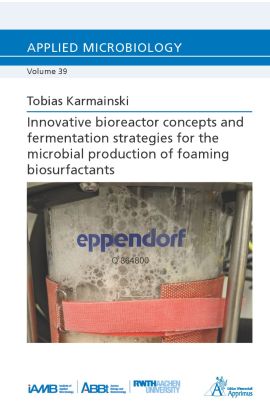Biosurfactants are promising alternatives to conventional surfactants derived from fossil resources. This thesis focused on developing bioprocesses for two different biosurfactants: the glycine-glucolipid of Alcanivorax borkumensis SK2 and rhamnolipids with recombinant Pseudomonas putida KT2440. However, excessive foam formation is the main challenge, hurdle, and objective to be solved in this thesis and all surfactant production bioprocesses using aerated bioreactors. The physiology of A. borkumensis was explored, fed-batch fermentations using sustainable carbon sources like acetate were established, and aeration strategies were optimized using in situ membrane modules to enable bubble-free and foam-free operation. The static membrane module was improved regarding oxygen transfer rate by integrating a dynamic membrane stirrer.
Initially, A. borkumensis faced poor growth in published media formulations. Significant improvement was achieved by adjusting the medium composition. Various carbon sources were evaluated to stimulate glycine-glucolipid production. Aerated batch fermentations in a 3 L stirred-tank bioreactor using tetradecane and acetate achieved similar titers to shake-flask cultivations, and bubble-free membrane aeration successfully addressed foam formation.
Urea emerged as the most promising nitrogen source for glycolipid production. Investigating different C/N ratios revealed an increase in glycolipid production to 300 mg L 1 with decreasing biomass production, with the optimal C/N ratio being between 17.6 and 26.7 Cmol Nmol 1. A pH-stat fed-batch using glacial acetic acid showed the highest glycolipid titer of 430 mg L 1.
Finally, a previously used static membrane module was optimized to increase the oxygen transfer rate by implementing an innovative dynamic membrane stirrer. This novel aeration device was tested for rhamnolipid production using recombinant P. putida in batch and fed-batch modes, achieving a maximum oxygen transfer rate of 175 mmol L 1 h 1 and a high space-time yield of 118 mg L-1 h-1 in a foam-free rhamnolipid production process.
In summary, significant progress was made in biosurfactant production, with practical implications for industrial upscaling. The physiology of A. borkumensis was explored, and the first bioreactor runs were successful. The new dynamic membrane stirrer enabled foam-free rhamnolipid fed-batch fermentations with P. putida, eliminating oxygen limitations and enhancing productivity.
| Autor | Karmainski, Tobias |
|---|---|
| Gewicht | 0.252 kg |
| Erscheinungsdatum | 31.03.2025 |
Eigene Bewertung schreiben
Applied Microbiology
Innovative bioreactor concepts and fermentation strategies for the microbial production of foaming biosurfactants
ISBN: 978-3-98555-272-6
Lieferzeit: 2-3 Tage
54,00 €
inkl. 7% MwSt.
Kurzbeschreibung
Biosurfactants are sustainable alternatives to synthetic surfactants. Bioprocesses were developed for glycine-glucolipids from Alcanivorax borkumensis and rhamnolipids with recombinant Pseudomonas putida. Excessive foam formation was addressed using optimized aeration strategies and a novel dynamic membrane stirrer. Improved media and feeding strategies enhanced glycolipid yields, while foam-free rhamnolipid production achieved high space-time yields, advancing industrial applicability.
Auf Lager

